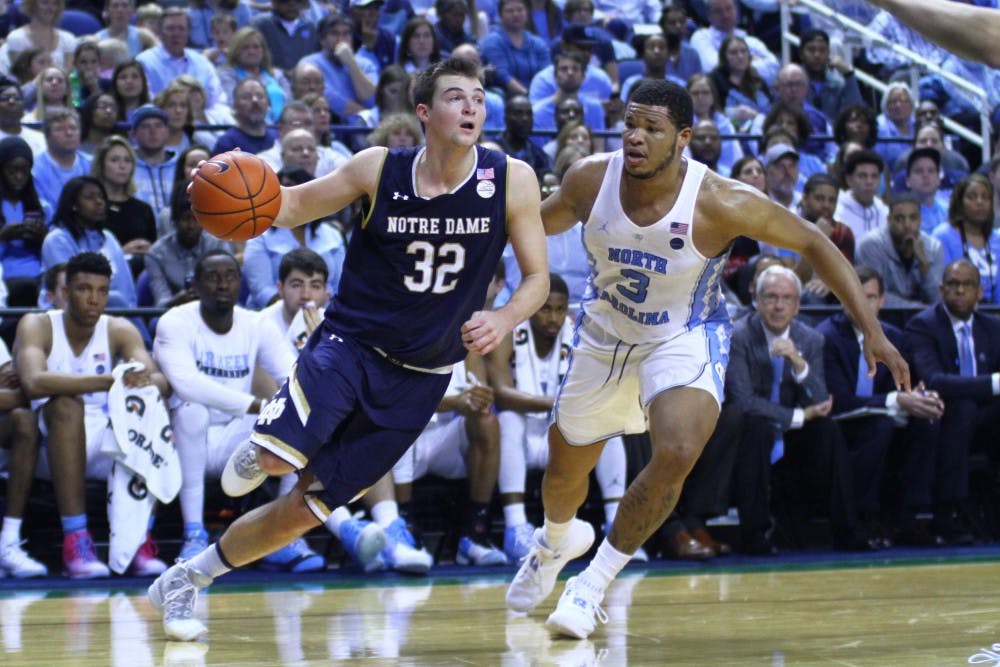A team's offensive rating is based on how many points its offense scores per 100 possessions. Here’s how it shakes out for UNC over the years.
2004-05: 118.7 (2nd in the country)
2007-08: 118.2 (1st)
2008-09: 119.8 (1st)
2015-16: 123.3 (1st)
2016-17: 122.4 (7th)
Roy Williams’ great teams always have great offenses. There is some variation in how they get there, but his best teams have been either first or second in the country in this category. This North Carolina team is good — as you can see, scoring 122.4 adjusted points per 100 possessions is better than the teams in the 2000s did — but it has to keep improving to get into that top tier.
Areas for improvement are ball movement and attacking the paint. North Carolina has struggled at times this season when playing stagnant and settling for jump shots and 3-pointers instead of getting into the teeth of the defense. It helps to be able to attack the basket when the jumpers aren't falling. UNC has made progress, but it can keep going in this aspect.
I don’t think the offense of the 2016-17 team is the top concern, though. That comes on the other end of the floor.
Defensive rating
This stat is the same as offensive rating, except lower is better because it’s how many points the other team is scoring.
To get the day's news and headlines in your inbox each morning, sign up for our email newsletters.
2004-05: 86.5 (7th in the country)
2007-08: 88.6 (17th)
2008-09: 89.3 (21st)
2015-16: 93.5 (21st)
2016-17: 96.4 (35th)
North Carolina’s best teams under Williams haven’t been great defensive teams. Over his 14 years at UNC, his best adjusted defensive efficiency mark was in 2010-11, when his team ranked 4th in the nation (86.0). That team went 29-8 and lost to Kentucky in the Elite Eight.
There’s a cutoff, though, as the top Tar Heels teams usually maintain a top-25 defense. North Carolina falls just outside that cutoff this season, ranking 35th in the nation. UNC’s defense has struggled the past few games, in particular, after excelling earlier in the year.
There’s room to improve, though. North Carolina does a poor job at times in the first line of defense by allowing dribble drives to opponents. These drives set off a chain reaction of rotations that almost always end poorly for the Tar Heels. And no matter how unfairly the refs may treat Isaiah Hicks and others in the eyes of the Tar Heel faithful, North Carolina has to find a way to manage its fouls better. Conceding free throws in March is always a killers.
The Tar Heels can and will have to improve defensively in order to climb back into the same range as Williams’ other Final Four teams.
High-usage big man
All of Williams’ best teams at North Carolina have had one big man who uses a lot of possessions and dominates the post. The stats I’ll be using in this category are percentage of possessions used, offensive rating, true shooting percentage and fouls drawn per 40 minutes.
2004-05: Sean May
%Poss: 28.0 (87th in the country), ORtg: 118.6 (82nd), TS%: 62.0 (80th) and FD/40: 7.3 (17th)
2007-08: Tyler Hansbrough
%Poss: 26.8 (189th), ORtg: 125.2 (22nd), TS%: 61.8 (105th) and FD/40: 8.1 (3rd)
2008-09: Tyler Hansbrough
%Poss: 26.7 (194th), ORtg: 124.0 (26th), TS%: 61.3 (93rd) and FD/40: 7.8 (4th)
2015-16: Brice Johnson
%Poss: 24.6 (384th), ORtg: 126.8 (23rd), TS%: 64.9 (25th) and FD/40: 5.2 (339th)
2016-17: Kennedy Meeks
%Poss: 24.0 (456th in the country), ORtg: 115.3 (323rd), TS%: 52.7 (unranked) and FD/40: 4.7 (491)
The stat profiles of these players — and their strengths and weaknesses in certain categories — vary because they are different types of big men. However, it's clear all of Williams’ best teams had someone to throw the ball to on the block when the game got tough.
The jury is still out on whether Kennedy Meeks can really be that guy for the Tar Heels. As you can see above, he’s not quite on the same level as the others in offensive efficiency and at getting to the line. To be fair, he is a great rebounder — he has the fourth-best offensive rebounding rate and 50th-best defensive rebounding rate in the country. But his offensive production hasn’t yet been dominant, a claim that holds true if you watch a lot of tape of Meeks.
Joel Berry is right where some of Williams’ best point guards (Raymond Felton, Ty Lawson) have been, and Justin Jackson is doing his part on the wing. The takeaway here, though, is that Meeks has to take his game up another level to equal the profiles of some of Williams’ other Final Four teams.
Record against Duke
No explanation needed here.
2004-05: 1-1 against Duke (lost away).
2007-08: 1-1 against Duke (lost home).
2008-09: 2-0 against Duke.
2015-16: 1-1 against Duke (lost home).
2016-17: ???
North Carolina plays Duke on Thursday night. Even though these teams have three combined losses against the Blue Devils, some of the wins earned were big-time: think Marvin Williams’ putback at home in 2005, or Tyler Hansbrough going 2-0 against his archrivals his senior year.
UNC's best teams under Roy Williams have been able to compete and beat Duke consistently. Triumphant wins and close losses against the Blue Devils have also helped forge North Carolina's identity into a championship-caliber basketball team.
This Thursday's game could be a barometer to see the Tar Heels' progress and a catalyst as they continue along their path toward the tournament.
@bauman_john
sports@dailytarheel.com




